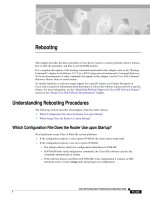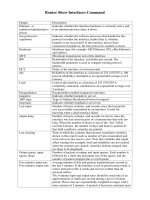Tài liệu quản trị mạng Access Server
Bạn đang xem bản rút gọn của tài liệu. Xem và tải ngay bản đầy đủ của tài liệu tại đây (44.12 KB, 8 trang )
CHAPTER
Access and Communication Servers Product Overview 1-1
Access and Communication Servers
Product Overview
1
This chapter provides an overview of the access server platforms. You will find the following
information in this chapter:
•
Introduction to access servers
•
Supported protocols
•
Supported interfaces and connections
•
Supported platforms
Introduction
Access servers connect terminals, modems, microcomputers, and networks over serial lines to
local-area networks (LANs) or wide-area networks (WANs). They provide network access to
terminals, printers, workstations, and other networks. Remote configuration is also available through
Telnet and Digital Equipment Corporation’s Maintenance Operation Protocol (MOP) connections to
virtual ports on access servers.
Note
Throughout the remainder of this publication, access servers and communication servers
generally are referred to as access servers.
Four Services
Your access server supports four types of server operation:
•
Terminal services—Connecting asynchronous devices to a LAN or WAN through network and
terminal-emulation software including Telnet, rlogin, Digital’s Local-Area Transport (LAT)
protocol, and IBM TN3270. See Figure 1-2.
•
Telecommuting services—Connecting devices over a telephone network using AppleTalk
Remote Access (ARA), Serial Line Internet Protocol (SLIP), compressed SLIP (CSLIP),
Point-to-Point Protocol (PPP), and XRemote (NCD’s X Windows terminal protocol). See
Figure 1-3 and Figure 1-4.
•
Routing services—Routing full-featured Internet Protocol (IP) and Novell Internet Packet
Exchange (IPX). This is the same routing functionality found on router platforms. See Figure 1-5.
•
Protocol translation services—Converting one virtual terminal protocol into another protocol.
See Figure 1-6.
1-2 Access and Communication Servers Command Reference
Introduction
Figure 1-1 illustrates these four types of server functionality available on the access server: terminal
service is shown between the terminals and hosts running the same protocol (LAT-to-LAT or
TCP-to-TCP); telecommuting service is demonstrated by the remote PC connection running SLIP,
CSLIP, PPP, or XRemote; protocol translation is supported between the terminals and hosts running
unlike protocols (LAT-to-TCP or TCP-to-LAT); asynchronous IP routing is shown by the PC
running SLIP or PPP, and between the two access servers.
Figure 1-1 Functions of the Access Server
.
LANs and WANs
On LANs, terminal services support TCP/IP on UNIX machines with Telnet and rlogin connections,
IBM machines with TN3270 connections, and Digital machines with LAT connections. You can use
the access server’s protocol translation services to make connections between hosts and resources
running different protocols including access server connections to X.25 machines using X.25 PAD.
Telecommuting services support WAN connectivity with ARA, SLIP, PPP, or XRemote. Other WAN
services include dial-on-demand routing (DDR) of IP and IPX, X.25, Frame Relay, and SMDS. Full
IP and Novell IPX routing services are also supported. Communication and access servers are
network-compatible with routers, which you can use to extend your network to any size you need.
Terminal (LAT)
Central Office
Terminal (TCP)
Terminal (XWindow)
Terminal (ASCII)
Telecommuter’s PC
(SLIP, PPP,
CSLIP, XRemote)
UNIX host (TCP)
VMS host (LAT)
Branch Office
PC (TCP) PC (LAT)
Access
server
IP
S2220
X.25 WAN
Access
server
Access and Communication Servers Product Overview 1-3
Introduction
Security Features
Full network access control features help to ensure system security and efficiency. Security features
provide restrictions to resources on the network. The network manager can specify access lists to
permit and deny users access to internetworked computers. A username and password-pair
authentication scheme is also supported.
Terminal Services
Access servers provide terminal-to-host connectivity using virtual terminal protocols including
Telnet, LAT, TN3270, rlogin, and X.25 PAD (X.25 PAD connections can be made with the ASM-CS
only). Modems can be configured for rotary connections so that users automatically connect to the
next available modem.
A host can also connect directly to an access server. In IBM environments, TN3270 allows a
standard ASCII terminal to emulate a 3278 terminal and access an IBM host across an IP network.
In Digital environments, LAT support provides a terminal with connections to VMS hosts. X.25
PAD allows terminals to connect directly to an X.25 host over an X.25 network through the
communication or access server. X.25 PAD eliminates the need for a separate PAD device. This
connection requires a synchronous serial interface.
Figure 1-2 illustrates terminal-to-host connections using an access server.
Figure 1-2 Terminal-to-Host Connectivity
Telecommuting
Using ARA, SLIP, or PPP, PC users can run TCP/IP applications and services including Telnet,
Simple Mail Transfer Protocol (SMTP), and File Transfer Protocol (FTP) over serial lines. The user
gets remote connectivity with the same functionality as a PC attached to a local network. Another
telecommuting option is to use the XRemote protocol over asynchronous lines. The access server
provides network functionality to remote X terminals.
Figure 1-3 illustrates an XRemote connection using an access server. See the chapter “Configuring
XRemote” in the Access and Communication Servers Configuration Guide for additional possible
XRemote configurations.
UNIX Host
S2223
Modem
PC acting as
a dumb terminal
Desktop NCD
terminal
Dumb terminal
Modem
Access server
1-4 Access and Communication Servers Command Reference
Introduction
Figure 1-3 XRemote Connection
Figure 1-4 shows a generic telecommuting connection.
Figure 1-4 Telecommuting Connection
S1923
Access server
UNIX Host
(TCP/IP)
DEC VMS
Host (LAT)
NCD X terminal
running XRemote
S2247
AppleShare
server
UNIX mail
server
AppleShare
Server
Access server
Modem
Modem
Modem
Modem
Macintosh PC (Windows '95)
Access and Communication Servers Product Overview 1-5
Introduction
Remote Access Routing
Access servers support full routing functionality, which enables them to determine the most efficient
path for sending data packets to a destination address outside the local network. The access server
gathers and maintains routing information to enable the transmission and receipt of such data
packets. Routing information takes the form of entries in a routing table, with one entry for each
identified route. The access server can create and maintain the routing table dynamically to
accommodate network-configuration changes when they occur.
Access servers allow you to route IP and IPX packets over synchronous and asynchronous lines.
Dial-on-demand routing (DDR) of IP and IPX packets is supported. A key feature of asynchronous
routing is its ability to provide low-cost operation over normal dial-up telephone networks. The
server’s routing capabilities provide remote home and sales offices with cost-effective access to a
central site. For example, traffic from PCs and UNIX workstations can be routed through the access
server, eliminating multiple phone lines and modems. Routing over asynchronous lines also
provides significant phone-line savings for small offices by allowing dial-up telephone lines to be
used rather than more costly leased lines.
All of the IP and IPX routing protocols and special features that are implemented on our routers are
available on your access server. Routing protocols include Internet Gateway Routing Protocol
(IGRP), Enhanced Internet Gateway Routing Protocol (Enhanced IGRP), Open Shortest Path First
(OSPF), Routing Information Protocol (RIP), Border Gateway Protocol (BGP), Exterior Gateway
Protocol (EGP), Gateway Discovery protocol (GDP), and ICMP Router Discovery Protocol (IRDP).
Special routing features include route filtering, priority queuing, access lists, and more.
Figure 1-5 illustrates an IP routing configuration using access servers. In this configuration, the host
is connected to an Ethernet and forms a routing connection with access servers at remote sites.
Figure 1-5 Asynchronous Remote Access Routing Connectivity
Host
Remote
Site
Remote
Site
Central
Site
S2222
Modem









